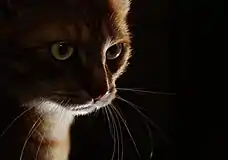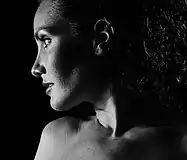Low-key lighting
Low-key lighting is a style of lighting for photography, film or television. It is a necessary element in creating a chiaroscuro effect.[1] Traditional photographic lighting (three-point lighting) uses a key light, a fill light and a back light for illumination. Low-key lighting often uses only a key light, optionally controlled with a fill light or a simple reflector.

Low key light accentuates the contours of the subject by throwing areas into shade while a fill light or reflector may illuminate the shadow areas to control contrast.[2][1] The relative strength of key-to-fill, known as the lighting ratio, can be measured using a light meter. Low key lighting has a higher lighting ratio, e.g., 8:1, than high-key lighting, which can approach 1:1.
The term "low key" is also used in cinematography and photography to refer to any scene with a high lighting ratio, especially if there is a predominance of shadowy areas. It tends to heighten the sense of alienation felt by the viewer, hence is commonly used in film noir and horror genres.[1] It is typically used in dark dramas/ thrillers. Low-key lighting is also associated with German Expressionism and later film noir.
- Low-key portraits



References
- Kindem, Gorham; PhD, Robert B. Musburger (2012-08-21). Introduction to Media Production: The Path to Digital Media Production. CRC Press. p. 245. ISBN 9781136053221.
- Pramaggiore, Maria; Wallis, Tom (2005). Film: A Critical Introduction. Laurence King Publishing. pp. 81. ISBN 9781856694421.